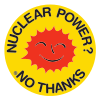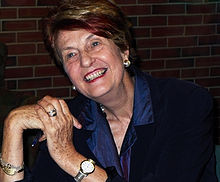Anti-nuclear movement in Australia
[6][7][8][9] The movement suffered a setback in 1983 when the newly elected Labor Government failed to implement its stated policy of stopping uranium mining.
[10] But by the late 1980s, the price of uranium had fallen, the costs of nuclear power had risen, and the anti-nuclear movement seemed to have won its case; CANE was disbanded in 1988.
[16][17] In 1969, a 500 MW nuclear power plant was proposed for the Jervis Bay Territory, 200 kilometres (120 mi) south of Sydney.
[6] A local opposition campaign began, and the South Coast Trades and Labour Council (covering workers in the region) announced that it would refuse to build the reactor.
[18] Some environmental studies and site works were completed, and two rounds of tenders were called and evaluated, but in 1971 the Australian government decided not to proceed with the project, citing economic reasons.
[6][19] The Ranger uranium deposits were first discovered by a joint venture between Peko-Wallsend and Electrolytic Zinc Corporation, by airborne survey radiometric signals in October 1969.
Remoteness and difficult terrain set the pace of ground investigation, but by about 1972 there was confidence that the Northern Territory of Australia hosted the largest and richest uranium deposits then known to the world.
[citation needed] The 1972–73 debate over French nuclear testing in the Pacific mobilised several groups, including some trade unions.
[20] In 1972 the International Court of Justice in a case launched by Australia and New Zealand, and advocated by Dr Helen Caldicott, ordered that the French cease atmospheric nuclear testing at Mururoa atoll.
[20] In 1975, Moss Cass, Minister for the Environment and Conservation, led parliamentarians and ALP branch members in expressing concerns about the effects of uranium mining.
[31] In 1977–78, the Government of Western Australia, under the leadership of Charles Court, announced plans for a nuclear power reactor near Perth.
Despite public protest, the Government of Western Australia selected a first site for a nuclear reactor in 1979 at Wilbinga, 70 kilometres (43 mi) north of Perth.
[11] In the 1980s, Australia experienced a significant growth of nuclear disarmament activism:[39] On Palm Sunday 1982, an estimated 100,000 Australians participated in anti-nuclear rallies in the nation's biggest cities.
[43] By the late 1980s, the price of uranium had fallen, and the costs of nuclear power had risen, and the anti-nuclear movement seemed to have won its case.
The plan, to store 20 per cent of the world's spent nuclear fuel and weapons material, was "publicly condemned and abandoned".
Several advanced projects, such as Honeymoon in SA, Jabiluka in the Northern Territory and Yeelirrie in WA were on hold because of political and indigenous opposition.
[45] Following the McClelland Royal Commission, a large clean-up was completed in outback South Australia in 2000, after nuclear testing at Maralinga during the 1950s contaminated the region.
[47] In late 2006 and early 2007, then Prime Minister John Howard made widely reported statements in favour of nuclear power, on environmental grounds.
[55] In November 2009, about 100 anti-nuclear protesters assembled outside the Alice Springs parliamentary sittings, urging the Northern Territory Government not to approve a nearby uranium mine site.
As of early April 2010, more than 200 environmentalists and indigenous people gathered in Tennant Creek to oppose a radioactive waste dump being built on Muckaty Station in the Northern Territory.
MPs clashed over the issue and protesters were marched from Sydney's convention centre before Prime Minister Julia Gillard's motion to remove a party ban on uranium sales to India was narrowly supported 206 votes to 185.
[67] In March 2012, hundreds of anti-nuclear demonstrators converged on the Australian headquarters of global mining giants BHP Billiton and Rio Tinto.
[73] In 2016 under Malcolm Turnbull, both Australian political parties opened the door for uranium exports to India,[74] with trade potentially starting in 2017.
[75] In 2015, South Australian Premier Jay Weatherill announced that a Royal Commission would be held to investigate the state's role in the nuclear fuel cycle.
The Royal Commission comes at a time of economic contraction for South Australia, which is suffering from job losses in mining and manufacturing sectors.
[76] On 17 April 2015, Lowe was selected as one of five members of the Nuclear Fuel Cycle Royal Commission Expert Advisory Committee.
This has been the case worldwide because of accidents like the Chernobyl disaster, but Australian concerns have also involved specific local factors such as controversy over the health effects of nuclear testing in Australia and the South Pacific, and the emergence of prominent anti-nuclear campaigners Helen Caldicott and Tilman Ruff, who are medical practitioners.
[41] A 2009 poll conducted by the Uranium Information Centre found that Australians in the 40 to 55 years age group are the "most trenchantly opposed to nuclear power".
[79] This generation was raised during the Cold War, experienced the anti-nuclear movement of the 1970s, witnessed the 1979 partial meltdown of the Three Mile Island reactor in the US, and the 1986 Chernobyl disaster.
It was the generation which was also subject to cultural influences including feature films such as the "nuclear industry conspiracies" The China Syndrome and Silkwood and the apocalyptic Dr Strangelove.









